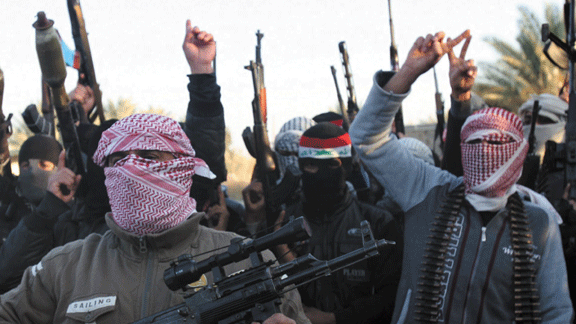Crisis in Iraq

Iraq and Syria stand on the verge of disintegration. These two states, carved out of the Ottoman Empire by the victorious imperial powers at the end of World War I, are threatening to blow themselves apart.
The map of the region could well be redrawn at a terrible cost. Millions of people, on top of the millions who have already died or been forced to flee from the murderous wars over the last decade, are set to have their lives destroyed.
In one conceivable scenario, Iraq could be divided into a Shi’ite state in the south (backed by Iran), a Kurdish state in the north-east and the rest of the country, combined with the greater part of Syria to become a sectarian Sunni state. In western Syria, the Assad regime might survive as the ruler of a small Alawite state.
Even if Iraq somehow manages to survive on paper as a unified state, the geopolitics of the region – the balance of power between US imperialism and the regional powers of Turkey, Iran and Saudi Arabia – is being fundamentally transformed. Old alliances are being recast.
If ever there was a case of the chickens coming home to roost, then George Bush’s war on Iraq undoubtedly takes the prize. An already fragile society was torn apart by the US occupation and has now erupted into another catastrophic sectarian war.
A century of interventions
The US invasion was only the most recent example of more than 100 years of imperialist intervention that have torn this oil-rich region apart by deliberately fomenting religious and ethnic strife in order to maintain strategic advantage and the flow of oil.
During World War I, Britain and France haggled over the spoils of the decrepit Ottoman Empire. Despite the promise of independence for the Arabs if they fought on the side of the allies, under the terms of the 1916 Sykes-Picot Agreement, France was to get present day Lebanon and Syria while Britain grabbed the rest, including Iraq, Palestine, Kuwait and Jordan.
The Arabs got nothing. The other great losers were the Kurdish people, who were denied their own state and arbitrarily divided between Iraq, Turkey, Syria and Iran.
In classic divide and rule tactics, the French colonialists broke greater Syria into two states – Lebanon and Syria – so that their favoured clients, the Maronite Christians, were better placed to control the Mediterranean coastal strip that was economically and strategically most important to French capitalists. The end result was the devastating communal strife that has plagued Lebanon for decades, compounded by repeated murderous Israeli attacks and two US invasions.
In the rest of Syria, the French colonialists armed the small Alawite minority to repress a rebellious population. This was a strategy continued by the brutal Assad dictatorships – father and son. The latter, in his determination to hang on to power to the bitter end, has reduced nearly the entire country to ruins.
In Iraq the British installed a Hashemite monarch from the Hejaz in Saudi Arabia. This puppet ruled over a country that had little to hold it together either economically or ethnically other than British aerial bombing of rebellious tribes. The mountains and plateaus of the north-east were dominated by Kurdish-speaking people, nominally Sunni but powerfully influenced by Sufism.
The predominantly Sunni Muslim Arabic-speaking people of the north, and their dominant city Mosul, were economically tied to Syria and its major northern city, Aleppo. The populous south was predominantly Shi’ite. Add to this, at the time of the British conquest, the significant divisions along tribal lines and the existence of numerous other minority groups including Turkomen, Persians, Christians, Assyrians and Jews.
The British sought to rule Iraq on the cheap without a large standing army. Initially they relied on currying the favour of various tribal sheikhs (and bombing the villages of any that stepped out of line) in order to use them against the populations of the cities and towns, which were the key centres of opposition to British rule. They also recruited a mercenary force from the small racial and religious minority of Assyrians.
Resistance
Nonetheless, revolt followed revolt, and a powerful working class movement gradually emerged that cut across the religious and ethnic divides. In July 1958, a popular revolution in Baghdad overthrew the monarchy, and the Iraqi Communist Party emerged as a powerful force. However, in February 1963, a CIA-initiated coup overthrew the nationalist regime, and at least 5,000 communists were murdered and thousands more imprisoned.
Within a few years, the left revived. In response, the US threw its full weight behind the rise to power of the vicious regime of Saddam Hussein. Despite the US’s subsequent demonisation of him, Saddam for a whole period was very much its man.
Saddam built a powerful Sunni-dominated state apparatus that crushed the working class movement and waged savage wars against the Kurds and Shi’ite rebels. Sectarian divisions became entrenched.
The US invaders further fuelled the sectarian divide as their prime means of hanging on to power. Current Prime Minister Maliki’s authoritarian, sectarian Shi’ite regime is very much their legacy.
Western imperialism is responsible for the current calamity.